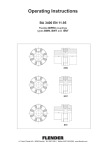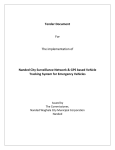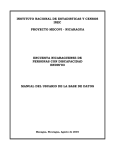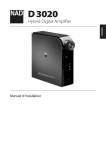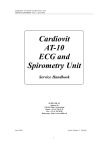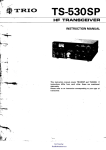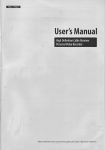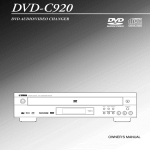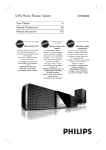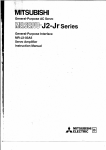Download JVC RX-D401 User's Manual
Transcript
<1> High-Power 7.1-Channel A/V Control Receivers -A Host of Digital Technologies Applied for Superior Sound, Pictures, and Style. JVC now offers the latest-generation of AV control receivers -- RX-D702, RX-D402, and RX-D401 -which feature a sleek profile to complement today’s and future home cinema systems. But what gears the units for the future home cinema is not only the stylish design. Despite the slim dimensions, the units are ready to deliver powerful, high-quality sound from various sources -- including PC music files -- and provide superior picture quality, too. What’s more, their expanded connectivity lets you easily connect the units with your PC, and even permits HDMI connections -- the latest interface for transmitting audio/video signals. Enabling these and many other feats are a host of advanced digital technologies newly incorporated into the units. In this technical guide, you will see the details of those technologies and find how the advanced A/V receivers will upgrade your digital home theater systems. <2> Design Concepts 1 High-Quality Pictures -- Advanced Technologies that Even Permit HDMI Compatibility 2 PC Link -- USB Connection for Receiving Uncompressed PCM Data from PC 3 CC Converter -- A JVC-Original Technology for Superior Sound 4 Aureus™ -- High-Performance DSP for Superior Sound Quality 5 Hybrid Feedback Digital Amplifier Ver.III -- An Upgraded Version of JVC-Trademark Digital Amp for Unmatched Sound Quality <3> 1 High-Quality Pictures The JVC A/V receivers deliver not only HDMI superior sound, but also superb pictures with a host of advanced technologies. The units feature HDMI terminals and use of DCDi by HDMI -- The Next-Generation Digital Interface 05 HDMI -- Easy Connections for All-Digital Transmission 06 FAROUDJA. DCDi by FAROUDJA Connection ConnectionExample Example----RX-D702 RX-D702 07 Connection ConnectionExample Example----RX-D402/RX-D401 RX-D402/RX-D401 08 What Whatis isDCDi DCDiby byFAROUDJA? FAROUDJA? 09 Effect Examples (1) 10 Effect Examples (2) 11 <4> HDMI HDMI HDMI ---- The The Next-Generation Next-Generation Digital Digital Interface Interface RX-D702 RX-D402 *Also applies to RX-D401 HDMI (High-Definition Multimedia Interface) -- An Industry-Supported, Digital Audio/Video Interface Developed for Next-Generation Home AV Devices. Its remarkable benefits include: 1. All digital provides the highest quality available -HDMI is the only interface in the industry that can handle both uncompressed high-definition video and uncompressed multichannel audio. Supported HD video formats include 720p, 1080i and even upcoming 1080p. 2. A single-cable connection for transmission of high-quality audio and video signals 3. HDCP (High-bandwidth Digital Content Protection) is supported Analog Digital Component Video DVI Video 3 1 Audio 2 2 Remote Control - - Yes PC Compatibility - Yes Yes Content Protection - Yes Yes Signal Format YPbPr RGB YPbPr/RGB Application Consumer AV PC Consumer AV Cable HDMI 1 HDMI Founders Hitachi Matsushita (MEI) Philips Silicon Image SONY Thomson Multimedia Toshiba <5> HDMI HDMI HDMI ---- Easy EasyConnections Connections for for All-Digital All-Digital Transmission Transmission RX-D702 RX-D402 *Also applies to RX-D401 Single-Cable Connections 5.1-ch Audio 2-ch Audio DVD Player 10 Audio + 9 Video Cables Display Receiver STB Component Video Display DVD Player Receiver 3 HDMI Cables STB All-Digital Transmission of High-Quality Video & Audio Even System Control is available Receiver Digital Display D/A Converter A/D Converter Digital <6> DCDi by FAROUDJA Connection Connection Example Example ---- RX-D702 RX-D702 RX-D702 DVD/VDR/D-VHS/STB Display 480i/p, 720p, 1080i PCM (DVD-Audio) / DD / DTS Hybrid Feedback Digital Amplifier FAROUDJA HDMI DVD-Audio SPDIF Speakers 480i/p, 720p, 1080i DSP RX TX HD, 480p A/D Converter Inputs Outputs HDMI HDMI Component Component S-Video S-Video Composite Composite Y Pb Pr 480p I/P Conversion 480i/p Up Converter Component OSD .... S-Video Composite <7> DCDi by FAROUDJA Connection Connection Example Example ---- RX-D402/D401 RX-D402/D401 RX-D402 *Also applies to RX-D401 DVD/VDR/D-VHS/STB Display 480i/p, 720p, 1080i PCM (DVD-Audio) / DD / DTS Hybrid Feedback Digital Amplifier DSP FAROUDJA HDMI DVD-Audio SPDIF Speakers 480i/p, 720p, 1080i RX TX 480p 480i A/D Converter Inputs I/P Conversion Outputs HDMI HDMI Component Component S-Video S-Video Composite Composite Video Decoder .... Composite S-Video Component <8> DCDi by FAROUDJA What What is is DCDi DCDi by byFAROUDJA? FAROUDJA? RX-D702 RX-D402 *Also applies to RX-D401 The new A/V receivers can convert video signal format to HDMI for display on a compatible monitor, whether the signals are from Composite, S-Video, or Component input. In this process, the unit converts interlaced pictures to progressive ones -- a process known as “IP conversion” -using “DCDi by FAROUDJA”, a renowned, high-performance device. It features a host of advanced technologies for noise reduction and reproduction of high-definition pictures, including: 3D Deinterlacer Film Mode: Recreates the original film frames by accurately blending the fields back together in progressive scanning -- for images free of motion artifacts and with full vertical resolution. 3D Noise Reduction Filters out the noise temporally, without smearing or ghosting of moving objects in the image. Video Mode: Delivers pictures from video sources by eliminating jagged edges on diagonal lines. 3D Cross Color Suppression Prevents leakage of color information to chroma channels. Fleshtone Adaptive Noise Reduction Controls noise reduction coefficient to deliver optimum human flesh color. <9> DCDi by FAROUDJA VISUAL PROOF Effect Effect Examples Examples(1) (1) RX-D702 RX-D402 *Also applies to RX-D401 3D Deinterlacer A unique algorithm that identifies all the moving edges in a scene and adjusts the angle of interpolation at each pixel so that the interpolation always follows the edge instead of crossing it, eliminating staircasing or jagged edge artifacts. Cross-Color Suppression Jagged Edges on Diagonal Lines Smooth diagonal lines are also delivered by the 3D Deinterlacer. Smooth Diagonal Edges While composite signals are decoded, high-frequency luma information leaks into the chroma channel, generating noise that looks like flashing colors or rainbow patterns. The Cross-Color Suppression effectively eliminates the noise with high-performance chroma processing. < 10 > DCDi by FAROUDJA VISUAL PROOF Effect Effect Examples Examples(2) (2) RX-D702 RX-D402 *Also applies to RX-D401 Fleshtone Adaptive Noise Reduction Noise reduction applied on overall picture may cause an adverse effect -- unnatural flesh color. The Fleshtone Adaptive NR detects flesh color contained in a picture and controls noise reduction coefficient to deliver optimum human flesh color. Red Cr Magenta CbMi CbMa Fleshtone CrMa Yellow CbCrdiff Cb Blue CbCrdif Corner Cutouts Defined by ABS(Cb-Cr)=CbCrdiff Green Cyan Definition of Fleshtone Area in Color Vector Field < 11 > 2 PC Link -- USB Connection for Receiving Audio Signals from PC The RX-D702 permits transmission of stereo audio signals from your PC (MP3, WMA, Wireless USB Connection Superior Sound Quality Matching CD/DVD 13 User ID Learning Function & Auto Scan 14 Comparison of Signal Formats 15 Linear PCM, etc.) for listening via your audio system. The unit even permits wireless USB transmission, which ensures superior, nearCD sound quality as well as enhanced convenience. USB Connection Transmission of Stereo Audio Signals from PC 16 < 12 > Wireless USB Connection Superior Superior Sound Sound Quality QualityMatching Matching CD/DVD CD/DVD RX-D702 (((( ) ))) (((( ) ))) ( ( ( Note PC or Desk-Top PC Max. reach is 30m, but this depends on the environment. ( ( ( ( ( USB Connection (1) The 2Mbps high transmission rate using the 2.4GHz band permits transmission of uncompressed signals for lossless reproduction. (2) Input signals are free of D/A or A/D conversion until just before output, which prevents conversion loss. (3) Use of DSSS (Direct Sequence Spread Spectrum) modulation technology enables transmission of uncompressed signals with superior resistance against noise, which retains superb sound quality. (4) Corresponds to 16-bit, 32kHz/44.1kHz/48kHz sampling rates. (5) Almost real-time data transmission -- delay time is only 2 msec or less. < 13 > Wireless USB Connection User User ID ID Learning Learning Function Function && Auto Auto Scan Scan RX-D702 User ID Learning Function Auto Scan To ensure security, the wirelss USB transmitter and the RX-D702 share a specific “user ID”. This means devices without the same ID cannnot receive signals from the transmitter. And when you replace the transmitter, “User ID Learning Function” would be convenient. This function lets you easily set up a new user ID, so that the unit can receive signals from the new transmitter. The Wireless USB additionally features “Auto Scan”, which stops interruption from other signals in the same room. When the system is turned on, this function automatically detects electric waves from other devices -- wireless LAN, for example -- and selects a band that won't be interrupted by the other signals. When the signal transmission is interfered by other waves while using the unit, simply press and hold the “Channel Key” (on the transmitter) for a few seconds. The transmitter automatically switches the band to a one that won’t be interfered by the waves. Transmitter Channel Key ID Key Channel No. Center Frequency Channel No. Center Frequency 1 2,412 MHz 8 2,447 MHz 2 2,417 MHz 9 2,452 MHz 3 2,422 MHz 10 2,457 MHz 4 2,427 MHz 11 2,462 MHz 5 2,432 MHz 12 2,467 MHz 6 2,437 MHz 13 2,472 MHz 7 2,442 MHz < 14 > Wireless USB Connection Comparison Comparison of of Signal Signal Formats Formats RX-D702 Bluetooth Compression Format Data Rate (due to low data rate) Delay Time Approx. 400msec 1Mbps JVC Wifi/802.11b No Compression 2Mbps Compression No Compression 11Mbps Under 2msec Approx. 600msec Our Outstanding Points (Compared with Other Wireless Products) Feature Model A Model B Ethernet Ethernet Wireless LAN (Optional) Wireless LAN (Optional) Wired Wireless PCMCIA Card Slot: for still pictures from digital cameras Exclusive Network Only Control with OSD: = Movie, Music, Pictures JVC Advantages O No optional device required. O Receives signals from any PC (including Mac). O CC Converter improves the sound quality of compressed music files from PC. < 15 > USB Connection Transmission Transmission of of Stereo StereoAudio Audio Signals Signals from from PC PC RX-D702 RX-D402 *Also applies to RX-D401 ( ( (( )) )) ( ( (( )) )) Note PC or Desk-Top PC USB Connection (1) Corresponds to 16-bit, 32kHz/44.1kHz/48kHz sampling rates for superior sound. (2) Permits playback of any music files that can be played on the connected PC, regardless of the software (Windows Media Player, iTunes, etc). (3) All-digital transmission --> No D/A or A/D conversion. < 16 > 3 CC Converter -- A JVC-Original Technology for Superior Sound K2 Processing is the result of a close collaboration among JVC studio engineers, CC Converter Background 18 Problems with Digital Conversion 19 Problem: An analog signal of a very faint strength cannot be accurately recreated by A/D and D/A conversion. (1) 20 one of its applications to improve the sound Problem: A high-frequency analog signal cannot be accurately recreated by A/D and D/A conversion. (2) 21 quality of not only pure audio sources but CC Converter 22 Bit Expansion Section 23 Frequency Conversion Section/Range Expansion Section 24 CC Converter: How its workings differ from other high-bit/upsampling systems 25 Comparison of -90dB, 1kHz Sine Waves: Bit Expansion On vs. Off 26 Comparison of Frequency Spectra: Range Expansion On vs. Off 26 producers and hardware engineers, embodying the elaborate algorithms for a sound quality that is close to the master by professional standards. The CC Converter is also compressed files, such as dts, Dolby Digital, and MP3. The CC Converter lets you experience a sound that is truer to the original master than ever. With the RX-D702, front L/R channels are processed by the CC Converter. P.E.M. D.D. Converter D.D. Converter 27 Noise Shaping Response/Noise Spectrum 28 192kHz/24-bit and 96kHz/24-bit A/D Converters -- RX-D702 29 192kHz/24-bit and 96kHz/24-bit A/D Converters -- RX-D402/D401 30 < 17 > CC Converter Background Background RX-D702 Digital audio started with Compact Disc and has since given birth to such super high-fidelity formats as DVD Audio and SACD. There’s another trend in digital audio: compressed data formats. Music distribution over the Internet, silicon audio using compact IC cards, and digital broadcast by satellite -- all these formats take advantage of audio compression technology. This means there are two diverging trends in digital audio -- higher fidelity and higher compression. JVC is not only a hardware maker but also a software producer as well, so there has been a close collaboration between the hardware engineers and studio engineers for all aspects of digital sound production. “K2 Processing Technology” is one of the many improvements developed by this collaboration to achieve higher sound quality. It was implemented as the “Extended K2 Processing,” a critically acclaimed application to pure audio. The CC Converter is an adaptation of this technology for compressed music. Therefore, it improves the sound quality of both hi-fi sources such as CD and DVD (Linear Mode) and compressed music formats including MP3 and WMA (Compression Mode), benefiting a wide range of digital audio contents. Sound Formats and Media: Quality vs. Compression 24-bit Higher Sound Quality DVD Audio LINEAR MODE (for CDs, DVDs, etc.) 20-bit 16-bit 12-bit 8-bit dts DD MP3 AAC MDLP SD COMPRESSION MODE CD (for MP3, WMA, etc.) Higher Telephone Compression Cellular 8kHz 44.1kHz 176.4/192kHz < 18 > CC Converter Problems Problemswith with Digital Digital Conversion Conversion RX-D702 In digital audio, music is processed in digital form. The music played by musicians in a recording studio or a concert hall is picked up by a microphone and recorded in digital form, to be released for sale as packaged media, including CD. The consumers buy the CD to play on a CD player: the recorded music is converted from digital to analog for playback through an amplifier and speakers. The process of playing digital music involves analog/digital conversion and digital/analog conversion as shown below. Process of Playing Digital Music The sound quality of a signal depends on the following two factors when the signal is converted from analog to digital. • Quantization wordlength (bits), which determines resolution or the expression of music in the amplitude domain. • Sampling frequency, which determines the frequency response or the expression of music in the frequency domain. < 19 > CC Converter Problem: Problem: An An analog analog signal signal of of aa very veryfaint faint strength strength cannot cannot be be accurately accuratelyrecreated recreatedby byA/D A/Dand andD/A D/Aconversion. conversion.(1) (1) RX-D702 When its level is high, a 1kHz signal can produce a smooth waveform after the A/D and D/A conversion. When the level is low, however, a stepped waveform results due to the limitation in the resolution of a digital signal. This phenomenon occurs because digital quantization distortion increases as the levels are reduced. A/D and D/A Conversion in Amplitude Domain < 20 > CC Converter Problem: Problem: AAhigh-frequency high-frequencyanalog analog signal signal cannot cannot be beaccurately accuratelyrecreated recreatedby byA/D A/Dand andD/A D/Aconversion. conversion.(2) (2) RX-D702 The “sampling theorem” says that, if the sampling frequency is more than twice as high as the maximum frequency of original signal, then the original signal can be retrieved by A/D and D/A conversion. With CDs, the sampling frequency is 44.1kHz, meaning the maximum frequency is band-limited to 22.05kHz. Therefore, the information on the waveform for over22.05kHz frequencies is not transmitted. Unless it’s sinusoidal, a signal contains multiple high-order harmonics. So does a square wave. If the input is a 1kHz square wave signal, it retains its shape because much of the information on the waveform for harmonics is retained after the A/D and D/A conversion. But if the input is a square wave of a high frequency, the converted signal presents a rounded shape because of the absence of information on high frequencies. A/D and D/A Conversion in Frequency Domain < 21 > CC Converter CC CCConverter Converter RX-D702 The CC Converter was developed to solve the problems with digital conversion by (1) increasing quantization resolution for low-level signals and (2) increasing the sampling frequency for high-frequency signals. Because bit expansion and oversampling alone do not guarantee better sound quality, the CC Converter features JVC’s original, advanced digital signal processing. CC Converter Block Diagram < 22 > CC Converter Bit Bit Expansion Expansion Section Section RX-D702 In the bit expansion section, the JVC-exclusive hi-fi processing generates a high-resolution 24-bit digital signal from a 16-bit signal. The process first analyzes the 16-bit digital signal to deduce the original analog signal before A/D conversion, and then applies hi-bit expansion to smooth the signal waveform. What’s more, the process ensures that the 24-bit signal preserves the same sound energy of the 16-bit digital signal. Hi-bit Expansion Processing < 23 > CC Converter Frequency FrequencyConversion ConversionSection Section RX-D702 The frequency conversion section doubles or quadruples the sampling frequency for playback of high-frequency signals that a following stage generates. Range RangeExpansion ExpansionSection Section The range expansion section applies the JVC-exclusive range expansion processing to compensate for the conversion distortion that occurs when the analog signal is converted into a digital signal. The human ear, it is said, cannot hear frequencies above 20kHz, but removing frequencies higher than 20kHz changes the waveform of audible frequencies, resulting in a signal that sounds different from the original. The range expansion section overcomes this problem by deducing the original waveform of a signal before A/D and D/A conversion and modifying the signal’s waveform accordingly. For playback of frequencies above 20kHz generated by this waveform processing, the range expansion section has a frequency conversion section preceding it. Range Expansion Block Diagram < 24 > CC Converter CC CCConverter: Converter:How How its itsworkings workingsdiffer differfrom from other other high-bit/upsampling high-bit/upsamplingsystems systems RX-D702 There are several high-bit/upsampling processing systems on the market that claim to offer the same benefits as the CC Converter. They are all designed to create and add frequencies (harmonics) over 20kHz deriving from an input signal. But we do not believe the mechanical addition of harmonics can ensure the faithful recreation of “musicality.” The sound generated by an instrument contains harmonic components. And it is the harmonic components that determine the tone of an instrument. The harmonic components of one violin are different than those of another. One player’s phrasing produces different harmonic components from one by others. Some instruments feature rich resonance, while others produce hardly any. Therefore, applying the same process for adding harmonic components is not proper in view of “musicality.” Reviewers of European audio magazines are highly critical of this approach. Moreover, the existing high-bit/upsampling processing systems use 2x sampling frequencies -- 88.2kHz for CDs to achieve a 44.1kHz frequency range, or 96kHz for DVD Video to achieve a 48kHz frequency range. CC Converter JVC’s CC Converter does not simply create and add harmonic components. It computes the data that was lost during the D/A conversion by taking advantage of JVC’s exclusive algorithms. This means the CC Converter has the processing power to recreate the original signal that should have been recorded -based on the digital signals for the audible range recorded on a CD. Accurate D/A conversion and reproduction of the recreated data requires a process to expand the frequency range of the analog signals. The frequency-range expansion of the analog signals to beyond 20kHz results in improved music data for the audible range. The CC Converter expands CD’s frequency range fourfold to 88.2kHz using 176.4kHz (44.1kHz x 4) sampling frequency. With DVD-Video, the frequency range is expanded to 96kHz, while the sampling frequency is 192kHz (48kHz x 4). < 25 > VISUAL PROOF CC Converter Comparison Comparison of of -90dB, -90dB, 1kHz 1kHz Sine SineWaves: Waves: Bit Bit Expansion Expansion On Onvs. vs. Off Off RX-D702 The figure shows the actual measured waveform of a bit-expanded -90dB sinusoidal signal. -90dB, 1kHz Sine Wave: Bit Expansion On -90dB, 1kHz Sine Wave: Bit Expansion Off Comparison Comparison of of Frequency FrequencySpectra: Spectra: Range Range Expansion Expansion On On vs. vs. Off Off The figure shows the frequency spectra of a music signal with the range expansion on and off. With the expansion off, the level is sharply reduced beyond 22kHz. But with the expansion on, the level is naturally extended beyond 22kHz and higher. LINEAR MODE (for CDs, DVDs, etc.) RX-D702 COMPRESSION MODE (for MP3, WMA, etc.) Level (dB) CC Converter ON Expansion ON Expansion OFF CC Converter OFF Frequency (kHz) Level Frequency (Hz) < 26 > P.E.M. D.D. Converter D.D. Converter RX-D702 RX-D402 *Also applies to RX-D401 The JVC exclusive D/A converter turns the 192kHz/24-bit output into an analog signal with impeccable accuracy. < 27 > VISUAL PROOF P.E.M. D.D. Converter Noise Shaping Response/Noise Spectrum RX-D702 RX-D402 *Also applies to RX-D401 Noise Shaping Response (Theoretical) Noise Spectrum Response (dB) Conventional D/A Converter Frequency (Hz) VANS=JVC Advanced Noise Shaper Response (dB) P.E.M. D.D. Converter Frequency (Hz) < 28 > VISUAL PROOF P.E.M. D.D. Converter 192kHz/24-bit and 96kHz/24-bit A/D Converters -- RX-D702 RX-D702 Digital IN Analog IN Coax A/D Converter Opti 1 L/R DVD Audio IN Opti 2 Opti 3 HDMI DIR USB DSP Aureus™ Aureus™ P.E.M. D.D. Converter L/R P.E.M. D.D. Converter USB Wireless TMS320DA601 Dolby Digital/PLIIx /DTS Digital/PLIIx/DTS HDMI DIT Digital Out CC Converter DAP/3DDAP/3D-H/GEQ/ DRC/BM Ls/Rs Ls/Rs P.E.M. D.D. Converter C/LFE D/A Converter SurrBackL/R SurrBackL/R < 29 > VISUAL PROOF P.E.M. D.D. Converter 192kHz/24-bit and 96kHz/24-bit A/D Converters -- RX-D402/D401 RX-D402 *Also applies to RX-D401 Analog IN A/D Converter Digital IN L/R Coax DVD Audio IN Opti 1 Opti 2 HDMI DIR DSP Aureus™ Aureus™ USB TMS320DA601 Dolby Digital/PLIIx /DTS Digital/PLIIx/DTS HDMI DAP/3DDAP/3D-H/GEQ/ DRC/BM DIT Digital Out P.E.M. D.D. Converter L/R P.E.M. D.D. Converter Ls/Rs Ls/Rs P.E.M. D.D. Converter C/LFE D/A Converter SurrBack L/R < 30 > 4 Aureus™ -- High-Performance DSP for Superior Sound Quality JVC exclusive DSP -- implemented by the JVC exclusive DSP Texas Instruments “Aureus”™ DSP -Texas Instruments Floating-Point DSP -- Aureus™ (TMS320DA601) 32 JVC’s DSP 33 field patterns that conventional processing Sound Field Analysis (Ray Tracing) 34 systems, based on field-measured impulse The reason why sound field simulation by DSP produces better results than one based on actual measured environments. 35 DAP Modes (1) 36 DAP Modes (2) 37 5-Band Graphic Equalization 38 3D Headphone 39 Midnight Mode 40 Center-Channel Alignment 41 Smart Surround Setup 42 simulates the acoustics of music venues. In doing so, it makes use of a vast amount of DSP-computed data for the creation of sound responses, have difficulties recreating. With JVC’s DSP, the sound fields are reproduced most naturally, with early reflections simulated realistically. More than ten years ago, JVC sent engineers worldwide to measure the acoustics of famous theaters and concert halls. JVC exclusive DSP embodies both the old know-how and latest technologies to make you feel you are there. < 31 > JVC exclusive DSP Texas TexasInstruments InstrumentsFloating-Point Floating-PointDSP DSP---- Aureus™ Aureus™ (TMS320DA601) (TMS320DA601) RX-D702 RX-D402 *Also applies to RX-D401 At the heart of the RX-D702/D402/D401’s DSP is a new high-performance Texas Instruments DSP -- Aureus™. It’s the world’s fastest, highest-performing chip of its kind now, replacing two conventional DSP chips. The JVC receiver is the world’s first to feature this LSI. Features • 1,800MIPS* or 1,350MFLOPS** (at 225MHz clock speed) -- one of the highest processing power ratings on the market • 32-bit (64-bit double precision) accurate operations • Decode formats: Dolby Digital, Dolby Digital EX, Dolby Pro Logic IIx, DTS, DTS-ES, DTS 96/24, DTS NEO:6 • Functions: DAP, 3D-PHONIC, 3D Headphone, DSP Digital Equalizer, Dynamic Range Control, Bass Management Advantages • A single chip performing DTS 96/24 processing and DAP (Digital Acoustics Processing) with power to spare • More accurate implementation of simulated DAP sound fields • Compact size conducive to reduction in digital noise • Floating-point operations for more accurate calculations with an expanded range of numbers * FLOPS (Floating Point Operations per Second): the number of floating-point calculations per second performed with real numbers. ** MIPS (Million Instructions per Second): A 1MIPS computer processes 1 million instructions per second. An “instruction” is a command sent out to a DSP to directly control and operate it. A DSP executes instructions stored in memory, makes calculations and outputs the result. The number represents a DSP or CPU’s capability of computing -- the greater the power of processing. < 32 > JVC exclusive DSP JVC’s JVC’sDSP DSP RX-D702 RX-D402 *Also applies to RX-D401 Listening to the 7.1-channel surround as processed by the JVC DAP (Digital Acoustics Processor) evokes a totally different surround sound experience from what you get from stereo or 5.1-channel sound. Listen carefully to the 5.1-channel sound of a DVD in its recorded form and you’ll notice it does not produce the sensation of being surrounded by sound. Stereo Playback JVC developed the DAP for one objective: to make the home theater audience feel as if they were in the best movie theater surrounded by an array of speakers to the left and right, and behind. Then they would feel enveloped in sound, with a helicopter, for instance, moving left to right, or front to back. 5.1-channel Playback JVC exclusive DSP, as implemented by the TI Aureus™ chip -- embodies the algorithms of sound field recreation that are developed specifically for advanced home theater receivers. The sound field patterns are created on the basis of the computer sound field simulation technology developed by a leading concert hall construction company. Patterns of reflections are calculated based on the data of the sound fields of the concert halls, theaters and movie theaters. 7-Channel DAP Playback *To verify simulated halls, the contractor creates a precision scaled-down miniature hall using the same materials for walls, seats, etc., in the same shape. A second larger scaled-down model will then be made to further refine the data. < 33 > JVC exclusive DSP Sound Sound Field Field Analysis Analysis (Ray (RayTracing) Tracing) RX-D702 RX-D402 *Also applies to RX-D401 The figure shows the paths of the “sound rays” as they propagate from a sound source (red, black and brown balls) to the receiver (blue ball). The DSP calculates the properties of a reflection sound (time delay and direction) from the paths of the sound rays. The simulation computations it does for 7.1-channel surround are different from those for 5.1-channel surround or for stereo. This means the DSP does optimal simulation computations according to the configuration of speaker setting. Rear Blue ball: receiver’s position (seating position) Brown ball up front: sound source (stereo 2-channel) 3 red balls up front: sound source (left, right and center channels) 2 red balls in the rear: sound source (surround left and right channels) (5.1channel surround consists of five red balls.) 4 green balls to the sides and in the rear: 7.1-channel surround consists of three red balls and four black balls. Front < 34 > JVC exclusive DSP The Thereason reason why whysound sound field field simulation simulation by byDSP DSPproduces producesbetter better results resultsthan than one one based based on on actual actual measured measured environments. environments. RX-D702 RX-D402 *Also applies to RX-D401 But measuring the sound field of an existing environment entails inaccuracies in the methodology. For instance, microphones have different characteristics, from model to model and from unit to unit. The measured data gives clues to time and level of a sound, but not to the direction. Measurements are made only at selected spots. Softest sounds are not captured accurately. Sound field simulation by DSP, on the other hand, can produce accurate data by supplying parameters, such as the shape of a hall, the shape and acoustic properties of interior materials, and the presence/absence of an audience. Because this data is not based on actual measurements that could be affected by the measuring equipment used or its inaccuracy, it allows the accurate recreation of the frequency response and even the direction of each reflection. Impulse Response Level To recreate an environment’s sound field, a real hall or cinema’s sound field is measured for data. For measurements, a pulse noise is emitted, its direct and indirect sounds are picked up by microphones, and their data is recorded. This is the approach adopted by other home theater receiver/processor manufacturers. Direct Sound Early Reflections Time Reverberations Time Series Analysis of Simulated Hall Acoustics < 35 > JVC exclusive DSP DAP DAP Modes Modes (1) (1) RX-D702 RX-D402 *Also applies to RX-D401 THEATER 1 THEATER 2 LIVE CLUB Capacity: 6,500m3 Seats: Approx. 600 Reverberation: 1.23 sec. Capacity: 2,000m3 Seats: Approx. 300 Reverberation: 0.55 sec. Capacity: 400m3 Seats: 70 Reverberation: 0.35 sec. DANCE CLUB PAVILION Capacity: 2,200m3 Seats: 240 Reverberation: 0.55 sec. Capacity: 549,700m3 Reverberation: 5.22 sec. < 36 > JVC exclusive DSP DAP DAP Modes Modes (2) (2) RX-D702 RX-D402 *Also applies to RX-D401 DAP Modes for RX-D702/D402/D401 Mode Signal 2 ch - THEATER 2 O* O* O* O* O* O* O* THEATER 1 - THEATER 2 - HALL 1 - HALL 2 - LIVE CLUB - DANCE CLUB - PAVILION - MONO FILM - O* O* O* O* O* O* O* O* O O O HALL 1 HALL 2 LIVE CLUB Multi-Channel DAP DANCE CLUB PAVILION THEATER 1 Pro Logic II Movie+DAP DTS 5.1 ch DAP O O O 3D Headphone 3D Phonic All Ch. Stereo - Dolby Digital 5.1 ch 2 ch Linear PCM Analog O* O* O* O* O* O* O* - - - - - - - - - - - - - - - - - - - - - - O* O* O* O* O* O* O* O* O O O O* O* O* O* O* O* O* O* O O O O* O* O* O* O* O* O* O* O O O - O O O *When the SURR. BACK SPK. setting is “ON”, the DAP performs 7-channel processing, outputting reverberation components to Surround Back channels. Mode For Recreation of Spatial Feel of : HALL 1 Large shoebox-shaped hall designed primarily for classical concerts HALL 2 Large vineyard-shaped hall designed primarily for classical concerts LIVE CLUB Live music club with a low ceiling DANCE CLUB Rocking dance club PAVILION Exhibition hall with a high ceiling THEATER 1 Large movie theater THEATER 2 Small movie theater MONO FILM For 3D-like reproduction of classic movies with mono soundtracks < 37 > JVC exclusive DSP 5-Band 5-Band Graphic Graphic Equalization Equalization RX-D702 RX-D402 *Also applies to RX-D401 A graphic equalizer lets you adjust the levels of center frequencies. The TI Aureus™ chip ensures high-speed processing for equalization, while it executes various decode processing (Dolby Digital, dts, etc.) An analog equalization circuit is built from resistors and capacitors, therefore noise and phase reversal are inevitable. A digital equalization circuit performs its function in the entirely digital domain. Clarity and consistent definition are its advantages. Center Frequencies: 63Hz, 250Hz, 1kHz, 4kHz, 16kHz Level: ±8dB, 2dB steps 1 manual EQ setting for each source 8 Response (dB) 10 Response (dB) 4 0 5 0 -5 -10 -4 -8 102 103 Frequency (Hz) 104 63 250 Ce nt 1k er Fr 4k eq ue 16k nc y( Hz ) 10 100 1 102 103 104 105 (Hz) ency Frequ < 38 > JVC exclusive DSP 3D 3DHeadphone Headphone RX-D702 RX-D402 *Also applies to RX-D401 In a typical listening room, sound from speakers you perceive consists of three elements: direct sound, early reflections (echoes from walls/ceiling/floor), and reverberation. These elements let you locate the sound source and recognize its size. This is called Head Related Transfer Function (HRTF). Direct Sound Reflections Virtual Sound Field Created by the 3D Headphone Technology Direct Sound Reflections Reverberations Sound Frequencies Detected in a Typical Listening Room In developing the 3D Headphone technology, JVC has applied an exclusive algorithm that divides the audio signals into the same three elements and conducts processing individually (convolution processing). This ensures that sound from headphones has the same realism, dynamism, and localization as that from multi-channel speakers. IN Direct Sound Processing Delay Delay OUT + Early Reflection Processing Reverberation Processing Block Diagram of Convolution Processing < 39 > JVC exclusive DSP Midnight Midnight Mode Mode RX-D702 RX-D402 *Also applies to RX-D401 INPUT High Low Midnight Mode Processing Mid High Level Mid Level Low OUTPUT Frequency Frequency Frequencies of Input/Output Audio Signals Level High Sound Levels Low Sound Levels Frequency Frequency of Output Signals The DSP divides input signals into three bands (LOW/MID/HIGH), and processes the signals so that low-level sound in each band will get louder and loud sound will be moderated. This makes the output sound clear across the range, regardless of the original levels. In addition, the unit individually controls the sound compression level of each band. When the sound level is low, the compression levels of high and low frequencies are raised to deliver enough loudness. When the sound level is high, the gains of the two frequencies are moderated to prevent excessive bass and treble output. These technologies combine to retain the excitement of multi-channel sound and keep dialog sound clear even at low sound levels. The technologies are applied even when the sound level is lowered suddenly, which is especially useful for midnight viewing, for example. < 40 > JVC exclusive DSP Center-Channel Center-ChannelAlignment Alignment RX-D702 RX-D402 *Also applies to RX-D401 The center speaker is usually placed on top of or under the display, while the front speakers are set at or near ear level. The result is that dialog, carried by the center speaker, seems out of place relative to music and sound effects. JVC's exclusive DSP application virtually positions the center speaker to align it with other speakers with respect to height. The dialog simply sounds more natural. Virtual Repositioning of the Center Speaker with Center Channel Alignment < 41 > JVC exclusive DSP Smart SmartSurround SurroundSetup Setup RX-D702 Setting up a home theater can be time-consuming and even confusing. Normally, you have to check which speaker channels (front, center, surround, and surround back) you have installed, the distance of each speaker from the listening position, and the level of each speaker. But with JVC's Smart Surround Setup Version 3.0, it takes just seconds to set up the acoustic environment of your home theater. Clap your hands, and the delay times of all channels are set individually, and the level of each speaker is automatically trimmed -- optimized for your listening position. You can even finetune the settings if you prefer. Setup information is displayed on-screen for easy confirmation. < 42 > 5 Hybrid Feedback Digital Amplifier JVC-exclusive Hybrid Feedback Digital Amplifier enables a lot more than the compact dimensions of the A/V receivers. Featuring dual analog feedback and digital feedback circuits, this device significantly “brushes up” the input signals, which ensures significantly lowered total harmonic distortion -- to 0.004% -- and superior speaker driveability. The result is high-quality sound matching that from a high-grade analog amp. The RX-D702 and RX-D402/D401 come with an upgraded “Ver. III” device, which incorporates a wide range of technological improvements for even better sound quality. Hybrid Feedback Digital Amplifier Background -- What is PWM? 44 Problems of Digital Amplifiers 45 Evolution of Hybrid Feedback Digital Amplifier (1) 56 Evolution of Hybrid Feedback Digital Amplifier (2) 47 Evolution of Hybrid Feedback Digital Amplifier (3) 48 Hybrid Feedback Digital Amplifier Ver. III -Technological Improvement for Even Better Sound Low-Voltage Power Supply 49 One-Chip Solution with JCV8015 50 JCV8015 Benefits (1) -- Operational Amp 51 JCV8015 Benefits (2) -- PWM Modulator/External Clock 52 JCV8015 Benefits (3) -- ±2.5V Regulator 53 Quality Parts for Superior Sound Reproduction 54 Comparison of Speaker Driveability 55 T.H.D. Comparison of Digital Amplifiers 56 < 43 > Hybrid Feedback Digital Amplifier JVC technologies for satisfying theBackground THX Ultra2 certification ---- What Background What is is PWM? PWM? RX-D702 RX-D402 *Also applies to RX-D401 Pulse Width Modulation (PWM) is a method of digitally encoding analog signal levels. In the process, continuously varying value of input audio signals is detected based on the reference voltage (Vref) by comparing the signals with triangular waves. When the value is higher than Vref level, the pulse is switched “ON”, and when it gets below Vref, it’s turned “OFF”. The higher than Vref the value is, the longer the pulse is kept “ON”. The lower than Vref the value is, the longer the pulse is left “OFF”. Thus, square-shaped waves are generated, representing either “ON” or “OFF” state of the pulse -- length of the “ON” and “OFF” pulses expresses the value of audio signals with respect to the Vref levels. These waves are called “PWM signals”. Precision of the PWM signals is one of the elements that determine the sound quality delivered by a digital amplifier. This is why “feedback” process is essential for delivering high-quality sound. PWM (Pulse Width Modulation) ON +1 +1 Switching Power Supply with Highly-Efficient Operations OFF ON Power MOS FET Switch ● Heat Generation 1. Loss from ON Impedance 2. Switching Loss Generation of PWM Signals 1. Values of input audio signals are detected by comparison with triangular waves. 2. High-precision triangular waves are necessary. OFF 0 Input Audio Signals Comparator OFF ON -1 -1 Triangular Waves PWM < 44 > Hybrid Feedback Digital Amplifier JVC technologies for satisfying the THX Ultra2of certification Problems Digital Problems of Digital Amplifiers Amplifiers RX-D702 RX-D402 *Also applies to RX-D401 With conventional amplifiers, the mechanism for digital signal processing tends to cause a wide range of noise. Analog Signal Processor Digital PWM Power Stage ● PCM-PWM ● Analog-PWM ■ ■ ■ ■ Slew Rate Fluctuation Power Supply Noise Dead Time EMI LC type LPF ■ Magnetic Distortion Error & Distortion Caused Caused at at Power Power Stage Stage and and After After *Even when the PWM signals are accurate, a wide range of noise is generated at power stage and after. < 45 > Hybrid Feedback Digital Amplifier JVC technologies for satisfying theof THX Ultra2Feedback certificationDigital Evolution Hybrid Evolution of Hybrid Feedback DigitalAmplifier Amplifier(1) (1) RX-D702 RX-D402 *Also applies to RX-D401 Hybrid Feedback Digital Amplifier Use of two feedback loops eliminates the noise generated at each process: Digital feedback -- for significantly improving the precision of PWM signal generation. Analog feedback -- for “brushing up” the waveform of the analog signal at output to match the original. 1 IN Digital feedback -- for significantly improving the precision of PWM signal generation + - PWM Modulator PWM PreDriver Demodulator (LPF) Phase Shift Master Clock Analog feedback -- for “brushing up” the waveform of the analog signal at output to match the original < 46 > Hybrid Feedback Digital Amplifier JVC technologies for satisfying theof THX Ultra2Feedback certificationDigital Evolution Hybrid Evolution of Hybrid Feedback DigitalAmplifier Amplifier(2) (2) RX-D702 RX-D402 *Also applies to RX-D401 Hybrid Feedback Digital Amplifier Ver. II Double analog feedback ensures even lower distortion. 2 IN + - PWM Modulator PWM PreDriver Demodulator (LPF) Phase Shift Master Clock Double analog feedback ensures even lower distortion. < 47 > Hybrid Feedback Digital Amplifier JVC technologies for satisfying theof THX Ultra2Feedback certificationDigital Evolution Hybrid Evolution of Hybrid Feedback DigitalAmplifier Amplifier(3) (3) RX-D702 RX-D402 *Also applies to RX-D401 Hybrid Feedback Digital Amplifier Ver. III Double analog & digital feedback loops for even lower total harmonic distortion. Use of newly-developed “JCV8015” for containing all the circuits. 3 IN Double analog & digital feedback loops for even lower total harmonic distortion + - PWM Modulator PWM PreDriver Demodulator (LPF) Phase Shift Master Clock JCV8015 < 48 > Hybrid Feedback Digital Amplifier Ver. Ver. III JVC technologies for satisfying the THX Ultra2 certification Low-Voltage Power Low-Voltage Power Supply Supply RX-D702 RX-D402 *Also applies to RX-D401 Hybrid Feedback Digital Amplifier Ver. III also features low voltage power supply, which ensures stable signal transfer. + Power Supply ~ Large-Capacity Power Transformer High-Efficiency Stabilized Power Supply Circuit Stabilized Quality Sound Digital Amp - Power Supply < 49 > Hybrid Feedback Digital Amplifier Ver. Ver. III JVC technologies for satisfying the THX Ultra2 certification One-Chip Solution with One-Chip Solution with JCV8015 JCV8015 RX-D702 RX-D402 *Also applies to RX-D401 The Hybrid Feedback Digital Amplifier Ver. III features use of a new IC dubbed “JCV8015”. This superior device, developed by JVC, contains all the circuits necessary for digital signal processing, including dual audio input circuits, the Hybrid Feedback Signal Processing Circuit, and PWM modulators. In addition to allowing a drastic reduction in parts and a smaller “footprint”, JCV8015 comes with the following features: Superior operational amp for low distortion and low noise High-precision PWM modulator -featuring synchronization by external clock Built-in ±2.5V regulator separated from analog GND < 50 > Hybrid Feedback Digital Amplifier Ver. Ver. III JVC technologies for satisfying the THXBenefits Ultra2 certification JCV8015 (1) JCV8015 Benefits (1)---- Operational OperationalAmp Amp RX-D702 RX-D402 *Also applies to RX-D401 Superior Operational Amp for Low Distortion and Low Noise High Slew Rate The operational amp comes with a higher slew rate -- two times higher than the previous types of devices -- to eliminate instantaneous “cross-modulation distortion”. Interference-Free Layout The operational amp features a symmetrical layout of parts and devices, which are completely separated for left and right channels. This prevents signal interference between the two channels (see the figure at right). JCV8015 -- Layout of Parts and Devices L-ch R-ch HighUltra-HighPrecision Speed Operational Circuit for Triangular Comparator Waves Amp with Selecting High Slew Max. +2.5V Rate Modulation Regulator -2.5V Operational Circuit for Regulator Amp with Selecting High Slew Max. HighRate Modulation Precision Ultra-HighSpeed Triangular Comparator Waves PAD L-ch out Symmetrical Layout Parts and devices for left and right channels are completely separated. --> Superior sound quality with no signal interference. R-ch out < 51 > Hybrid Feedback Digital Amplifier Ver. Ver. III JVC technologies for satisfyingBenefits the THX Ultra2 JCV8015 (2) PWM JCV8015 Benefits (2)----certification PWMModulator/External Modulator/External Clock Clock RX-D702 RX-D402 *Also applies to RX-D401 High-Precision PWM Modulator High-Precision Triangular Waves Distortion or irregular angles of the triangular waves lower the precision of PWM signals, which results in lower sound quality. The JCV8015 uses high-precision triangular waves to prevent the problem. Ultra-High-Speed Comparator Comparison of audio signals with the triangular waves is done by “comparator”. The JVC amp features an ultra-high-speed comparator. This prevents the possible delay of PWM signals with respect to audio signals, which causes distortion. Ultra-High-Speed Comparator Input Audio Signals High-Precision Triangular Waves PWM Synchronization by an External Clock Slight gap of frequencies among channels causes specific noise. To prevent this, the JVC amplifier uses an external clock, which synchronizes the operations of all channels. Noise is also generated when the unit receives AM signals whose frequency overlaps that of audio signals. The external clock detects this and automatically modifies the audio signal frequency of all the channels simultaneously, thus preventing the noise generation. < 52 > Hybrid Feedback Digital Amplifier Ver. Ver. III JVC technologies for satisfying the THXBenefits Ultra2 certification JCV8015 (3) JCV8015 Benefits (3)---- ±2.5V ±2.5VRegulator Regulator RX-D702 RX-D402 *Also applies to RX-D401 Use of the built-in ±2.5V regulator prevents digital noise interference to analog GND. VCC (Analog) +2.5V Regulator Improved Sound Quality Digital Circuits (PWM) PWM Analog Signals Analog Circuits (Operational Amp) -2.5V Regulator Analog GND VCC (Analog) Use of built-in ±2.5V regulator separates the path of current in digital circuits from analog GND. VDD (Digital, 5V) Analog Signals Analog Circuits (Operational Amp) Analog GND Digital Circuits (PWM) PWM Power supply to digital circuits causes the current to interfere with analog GND, which generates noise. < 53 > Hybrid Feedback Digital Amplifier Ver. Ver. III JVC technologies for satisfying THX for Ultra2 certification Quality Parts Sound Qualitythe Parts for Superior Superior Sound Reproduction Reproduction The superior technologies applied for the digital amp combine to lower the total harmonic distortion by a specific ratio (see the following pages for details). This means when the distortion of input signals are lower, that of output signals are lower than when input signals have higher distortion. This is why JVC engineers applied a wide range of quality parts for the A/V receivers. These devices ensure even better sound quality by sending low-distortion signals to the Hybrid Feedback Digital Amplifier Ver. III. 2SK3770-01MR IRFB4212 Power MOSFET used for the 150W digital amplifier of the RX-D702. Power MOSFET used for the 110W digital amplifier of the RX-D402/D401. RX-D702 RX-D402 IRS20124 ETQA15 High-performance Driver IC incorporated in the digital amplifiers of all the units. All the units feature highquality coils incorporated in the output low-pass filter, which help deliver superior sound. RX-D702 RX-D402 RX-D702 RX-D402 < 54 > Hybrid Feedback Digital Amplifier Ver. Ver. III VISUAL PROOF JVC technologies for satisfyingComparison the THX Ultra2of certification Speaker Driveability RX-D702 RX-D402 *Also applies to RX-D401 Usually, speaker impedance fluctuates according to the frequencies of audio signals. This “frequency response” of the speaker in turn fluctuates the levels of audio signals. How effectively an amplifier can control these fluctuations is called “speaker driveability”. The feedback processes of the Hybrid Feedback Digital Amplifier significantly improve the speaker driveability, retaining the same output level across the frequencies. RX-D702 Non-Feedback Amp Speaker Impedance with a Typical 2-Way Speaker < 55 > Hybrid Feedback Digital Amplifier Ver. Ver. III VISUAL PROOF JVC technologies for satisfying the THX Ultra2 certification T.H.D. Comparison of Digital Amplifiers RX-D702 RX-D402 *Also applies to RX-D401 10 1 THD + N [%] Non-Feedback Amp 0.1 0.004% 0.01 Hybrid Feedback Digital Amp (RX-D702) 0.001 0.01 0.1 1 10 100 Output Power [W] /6Ω < 56 > Supplementary Information OSD OSDSuperimposed Superimposedon onScreen Screen 58 RX-D702B RX-D702BAudio/Video Audio/VideoControl ControlReceiver Receiver 59 RX-D402B RX-D402BAudio/Video Audio/VideoControl ControlReceiver Receiver 60 Multi-Brand Multi-BrandA/V-STB A/V-STB(CATV/DBS) (CATV/DBS)Glow GlowRemote RemoteControl Control 61 Rear RearPanel Panel 62 < 57 > JVC technologies for satisfying the THXSuperimposed Ultra2 certificationon OSD OSD Superimposed on Screen Screen RX-D702 The RX-D702 displays a wide range of information -- including the Smart Surround Setup processes -- superimposed on your monitor screen to ensure easy recognition and control. Setting Menu Screen OSD for Smart Surround Setup Digital EQ and Bass Boost Setup Speaker Setup < 58 > JVC technologies for satisfying the THX Ultra2 certification RX-D702B Audio/Video Control RX-D702B Audio/Video Control Receiver Receiver 7-Channel Receiver Featuring HDMI, New Digital Amplifier, and Wireless PC Connectivity Basic Features • Stereo: 150 watts per channel, 6 ohms, from 20Hz to 20kHz, with 0.8% THD • Surround: (Front) 150 watts per channel, 6 ohms at 1kHz, with 0.8% THD; (Center) 150 watts, 6 ohms at 1kHz, with 0.8% THD; (Surround) 150 watts per channel, 6 ohms at 1kHz, with 0.8% THD; (Surround Back) 150 watts per channel, 6 ohms at 1kHz, with 0.8% THD • Dolby Digital EX/Dolby Digital/Dolby Pro Logic IIx/Dolby Pro Logic II • DTS/DTS-ES/DTS NEO:6/DTS 96/24 • DVD Multi-Channel Audio Compatible Product Highlights • Hybrid Feedback Digital Amplifier Ver. III • HDMI – for single-cable, all-digital transmission of audio and video signals • Wireless Connection with PC -- enjoy playback of music files from PC • CC Converter (2 Modes, Front Channels) -offers two modes for improving the sound quality of compressed audio and noncompressed sources, respectively • USB Input for receiving audio signals from PC • SIRIUS Input and SIRIUS Control on Remote • On-Screen Display • Center-Channel Alignment • Virtual Surround Back for creating even wider sound field without a surround back speaker • 3D-PHONIC • DAP for Multi-Channel Digital Sources: THEATER 1/THEATER 2/HALL 1/ HALL 2/ DANCE CLUB/LIVE CLUB/PAVILION • DAP for 2-Channel Sources: MONO FILM/THEATER 1/THEATER 2/HALL 1/ HALL 2/DANCE CLUB/LIVE CLUB/ PAVILION/ALL CH STEREO • 3D Headphone • 192kHz/24-bit P.E.M. D.D. Converter (Front/Center/Surround Channels) • Video Signal Up-Conversion (to HDMI) for single-cable output of high-quality video from any input terminals • Smart Surround Setup (Ver. 3.0) -- easy handclap setting up of the acoustic environment • One-Touch Operation • DSP Digital Equalizer • AV COMPU LINK • Multi-Brand A/V-STB (CATV/DBS) Glow Remote Control < 59 > JVC technologies for satisfying the THX Ultra2 certification RX-D402B Audio/Video Control RX-D402B Audio/Video Control Receiver Receiver 7-Channel Receiver with HDMI, PC Connection via USB and New Digital Amplifier Basic Features • Stereo: 110 watts per channel, 6 ohms, from 20Hz to 20kHz, with 0.8% THD • Surround: (Front) 110 watts per channel, 6 ohms at 1kHz, with 0.8% THD; (Center) 110 watts, 6 ohms at 1kHz, with 0.8% THD; (Surround) 110 watts per channel, 6 ohms at 1kHz, with 0.8% THD; (Surround Back) 110 watts per channel, 6 ohms at 1kHz, with 0.8% THD • Dolby Digital EX/Dolby Digital/Dolby Pro Logic IIx/Dolby Pro Logic II • DTS/DTS-ES/DTS NEO:6/DTS 96/24 • DVD Multi-Channel Audio Compatible Product Highlights • Hybrid Feedback Digital Amplifier Ver. III • HDMI -- for single-cable, all-digital transmission of audio and video signals • Video Up-Conversion (to HDMI) for singlecable output of high-quality video from any input terminals • USB Input for receiving audio signals from PC • Center-Channel Alignment • Virtual Surround Back for creating even wider sound field without a surround back speaker • 3D-PHONIC • DAP for Multi-Channel Digital Sources: THEATER 1/THEATER 2/HALL 1/HALL 2/ DANCE CLUB/LIVE CLUB/PAVILION • DAP for 2-Channel Sources: MONO FILM/THEATER 1/THEATER 2/HALL 1/ HALL 2/DANCE CLUB/LIVE CLUB/ PAVILION/ALL CH STEREO • 3D Headphone • 192kHz/24-bit P.E.M. D.D. Converter (Front/Center/Surround Channels) • Quick Speaker Setup • One-Touch Operation • DSP Digital Equalizer • AV COMPU LINK • Multi-Brand A/V-STB (CATV/DBS) Glow Remote Control < 60 > JVC technologies for satisfying the THX Ultra2 certification Glow Multi-Brand A/V-STB (CATV/DBS) Multi-Brand A/V-STB (CATV/DBS) Glow Remote RemoteControl Control For RX-D702B For RX-D402B/RX-D401S < 61 > JVC technologies for satisfying the THX Ultra2Rear certification Panel Rear Panel RX-D702B RX-D402B/RX-D401S < 62 > < 63 >































































